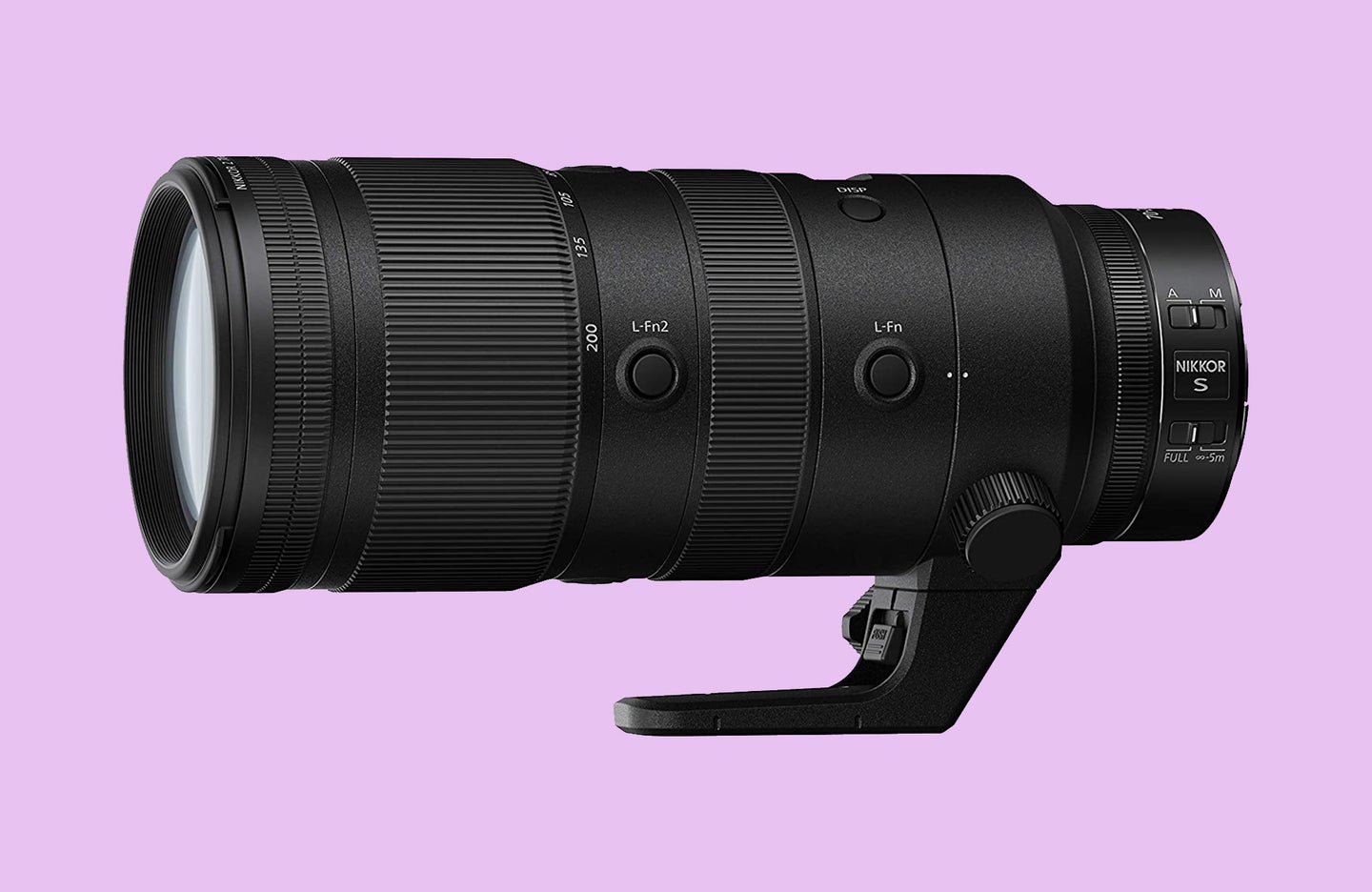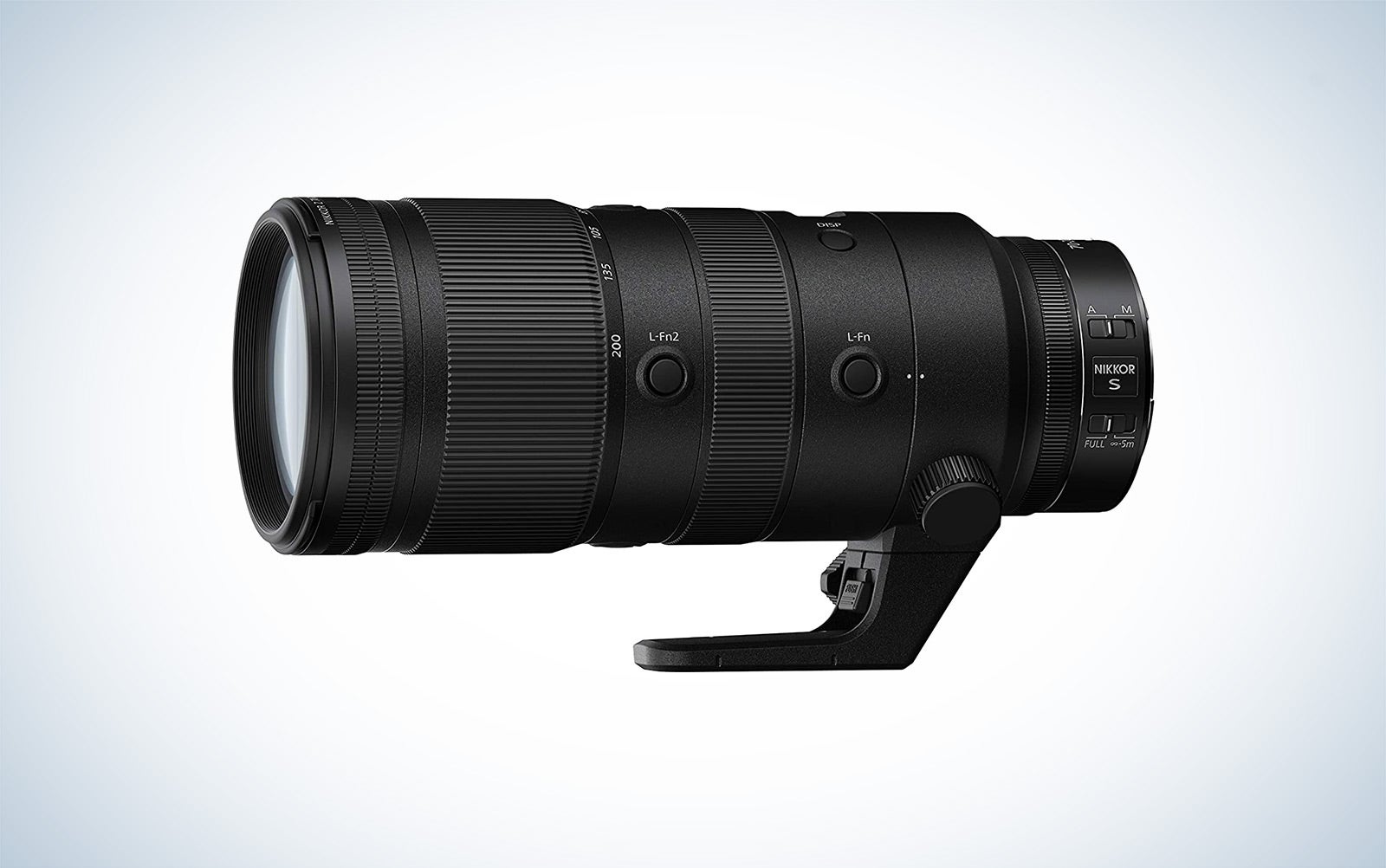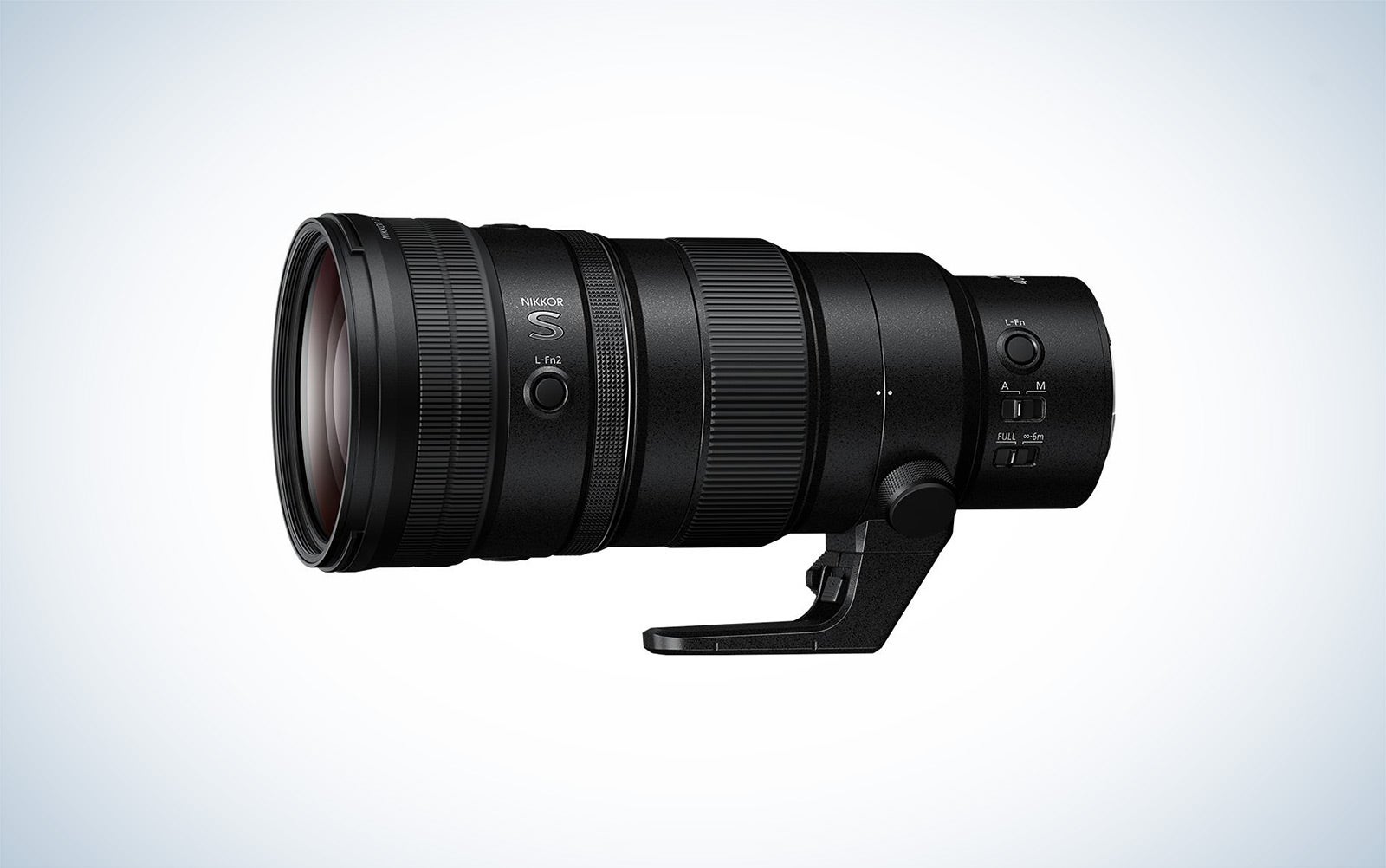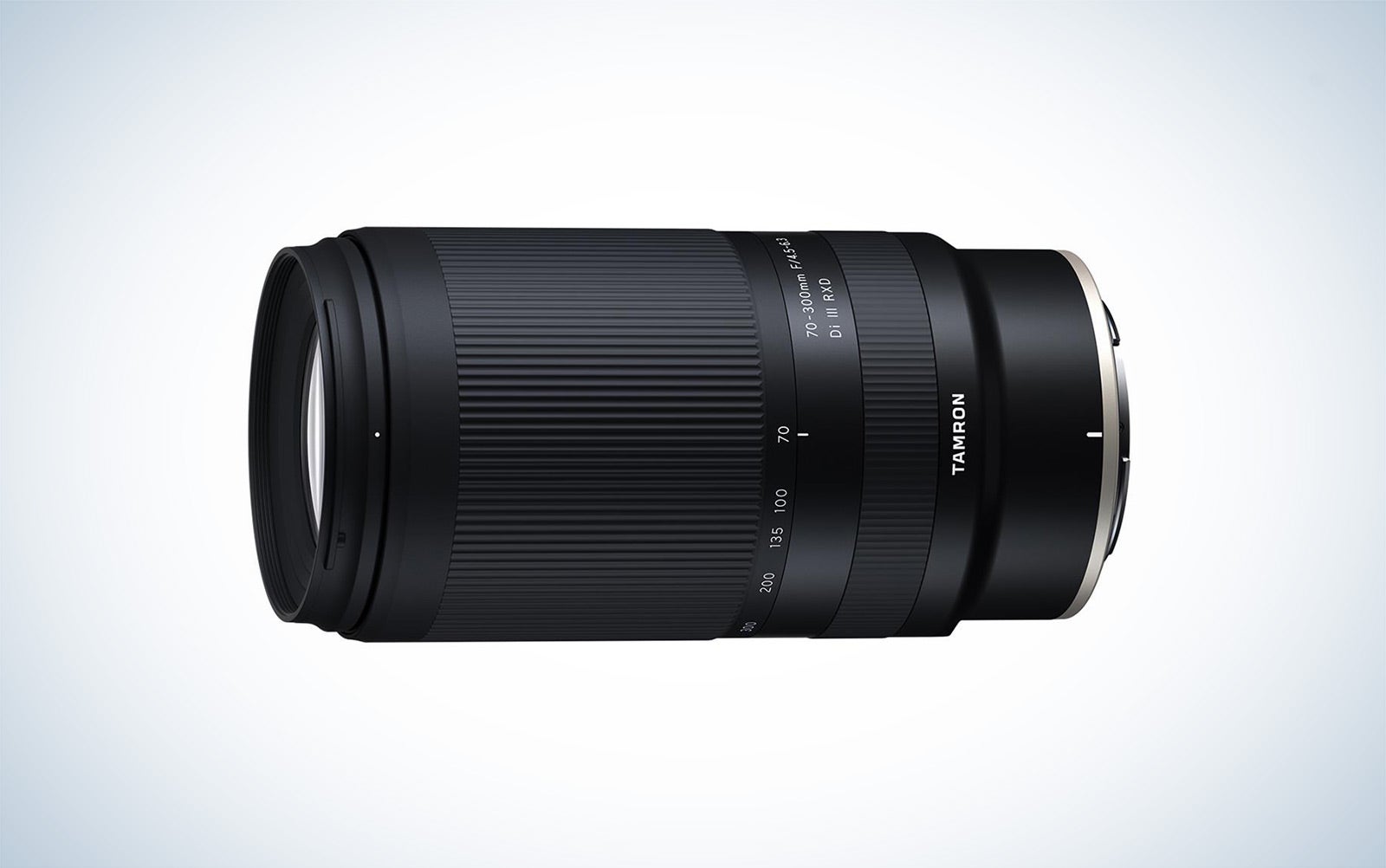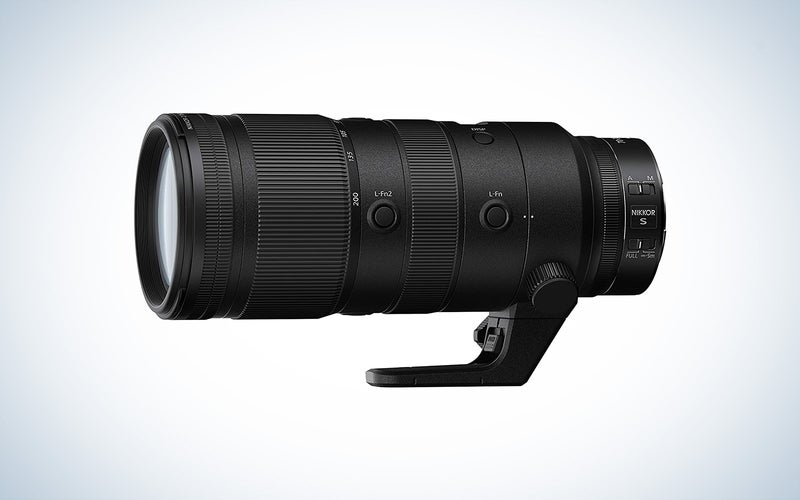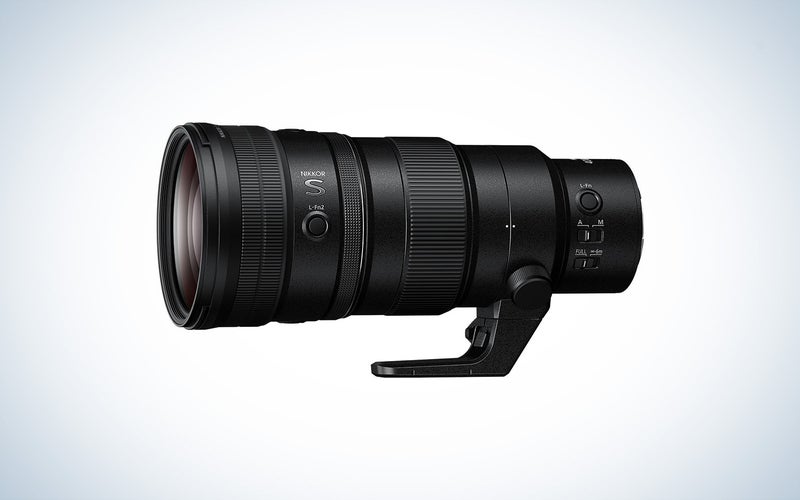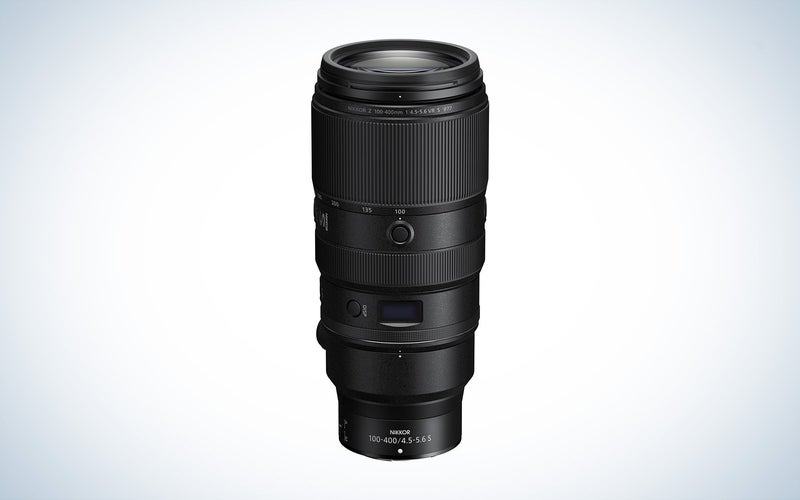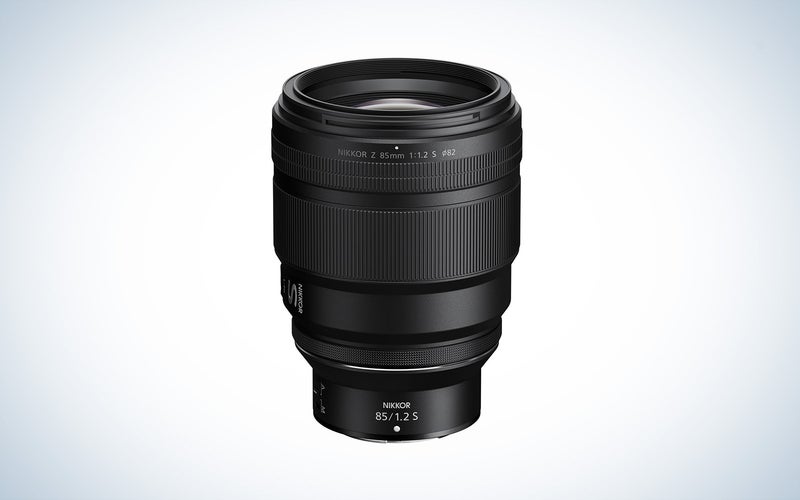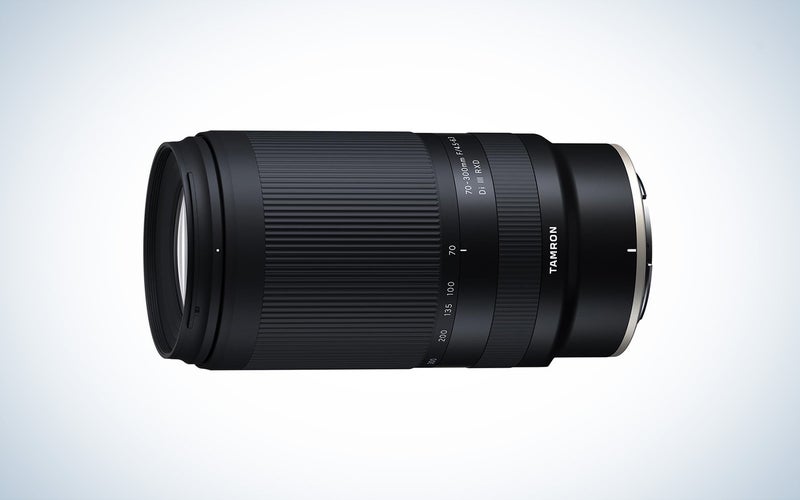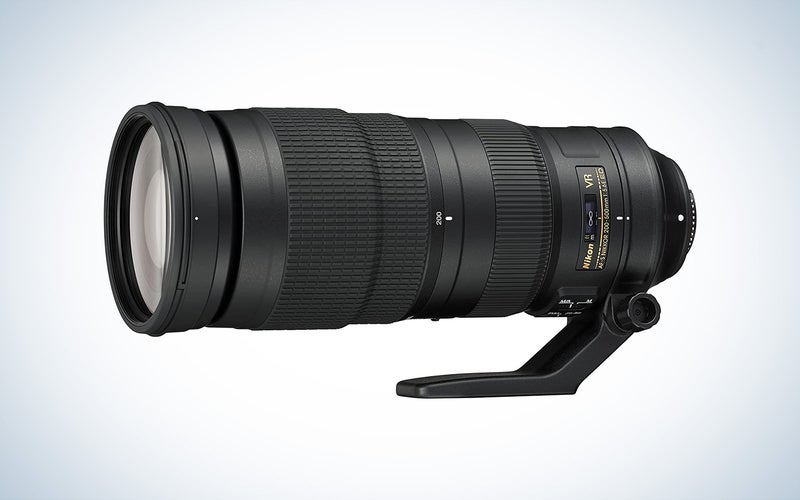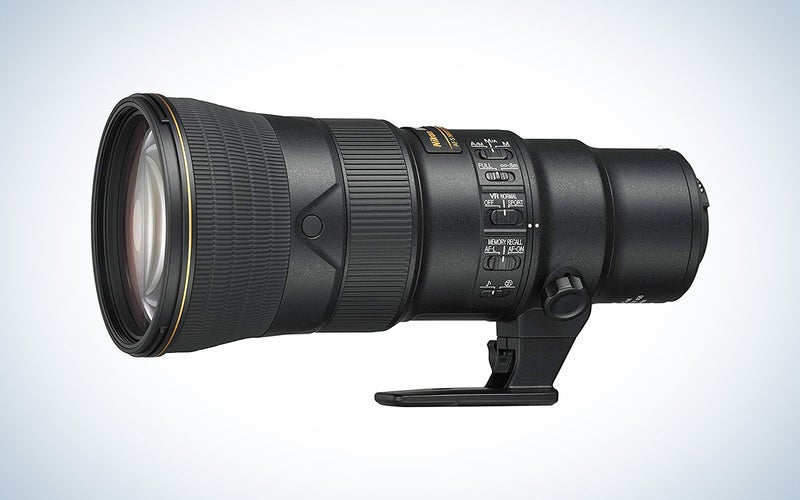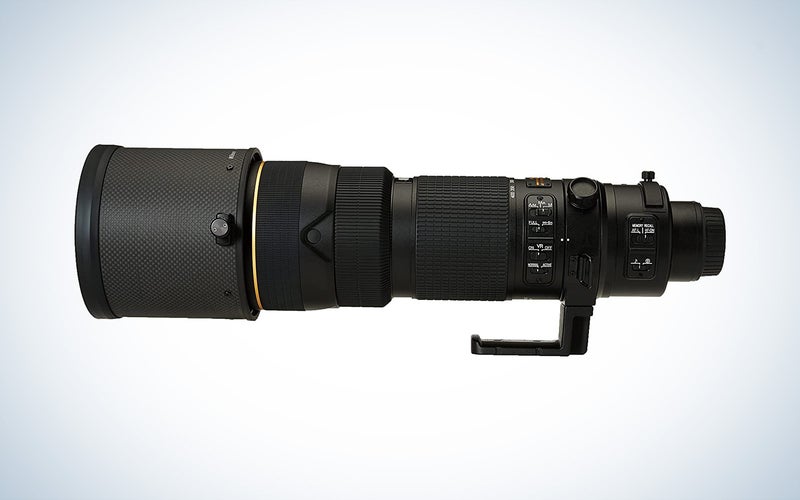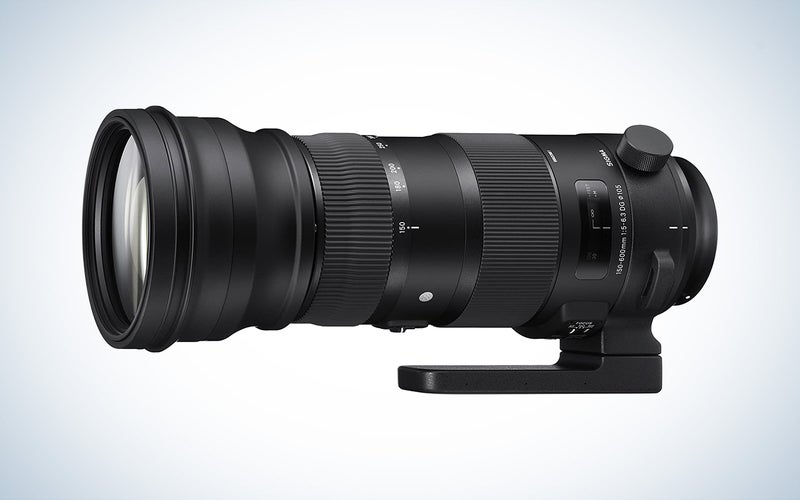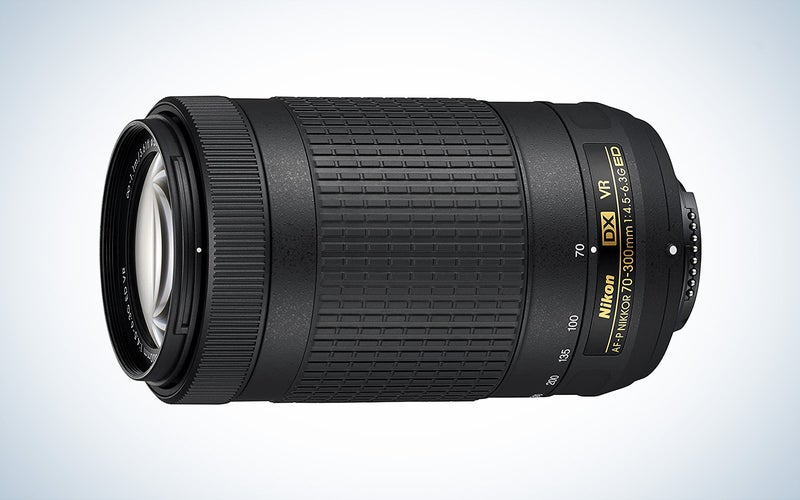We may earn revenue from the products available on this page and participate in affiliate programs. Learn more ›
Telephoto lenses for Nikon cameras allow photographers and video shooters to get close-up shots of distant, fast-moving, or dangerous subjects. The unrivaled range and versatility of the telephoto range have made these lenses a staple in photographers’ camera bags and wish lists since the advent of modern photography. Whether your subject is people, wildlife, or sports, a telephoto lens bestows the ability to narrow the field of view, isolate the subject, and allow the photographer to remain at a comfortable distance. The best telephoto lenses for Nikon will set you up for success regardless of your genre.
Best for Nikon mirrorless:
- Best overall: Nikon NIKKOR Z 70-200mm f/2.8 VR S Lens
- Best for wildlife: Nikon NIKKOR Z 400mm f/4.5 VR S
- Best value: Nikon NIKKOR Z 100-400mm f/4.5-5.6 VR S
- Best for portraits: Nikon NIKKOR Z 85mm f/1.2 S
- Best budget: Tamron 70-300mm f/4.5-6.3 Di III RXD
Best for Nikon DSLRs:
- Best overall: Nikon AF-S NIKKOR 200-500mm f/5.6E ED VR
- Best for wildlife: Nikon AF-S NIKKOR 500mm f/5.6E PF ED VR
- Best value: Nikon AF-S NIKKOR 200-400mm f/4G ED VR II
- Best third-party: Sigma 150-600mm f/5-6.3 DG OS HSM Sports
- Best on a budget: Tamron 70-210mm F/4 Di VC
How we picked the best telephoto lenses for Nikon
There were a lot of factors that went into determining the best telephoto lenses for Nikon cameras. None more so than mount type. Nikon has not introduced Z-mount alternatives for many of their telephoto lenses, leading to F-mount lenses being featured exclusively on this list. What Nikon lacks in Z-mount telephotos, they more than makeup for with unique, great-performing, and budget-conscious F-mount lenses. And with the addition of the FTZ adapter, more lenses are available for use with their mirrorless cameras than any other camera manufacturer. Versatility and budget were also heavily considered, as telephoto lenses can be notoriously expensive and limiting. We addressed these factors and provided options with exemplary quality, uniqueness, and performance, all while remaining relatively affordable.
The best telephoto lenses for Nikon mirrorless cameras: Reviews & recommendations
Best overall: Nikon NIKKOR Z 70-200mm f/2.8 VR S Lens
Nikon
Specs
- Lens mount: Z-mount, full-frame
- Aperture range: f/2.8 – f/22
- Image stabilization: Yes
- Filter size: 77 mm
- Minimum focus distance: 1.64 feet
- Weight: 2.99 pounds
- Dimensions: 3.5 x 8.66 inches
Pros
- Exceptional image quality
- Fast and quiet autofocus
- Compatible with teleconverters
- Excellent handling
Cons
- Tripod foot isn’t Arca compatible
- Pricey
70-200mm is an extremely versatile focal length ideal for a range of applications. It’s a fantastic tool for photographing weddings but also makes a great wildlife photography lens. And the Nikon Z-mount version is an excellent take on this classic focal length range. It features a bright and constant f/2.8 aperture capable of producing gorgeous bokeh.
Nikon built the lens around two AF drive units, resulting in speedy and accurate autofocus throughout the zoom range. And if you need even faster autofocus when working with subjects in the distance, there is a focus limiter switch. Focus is internal, so the lens balance won’t change as you focus. And it offers full-time manual focus override for fine-tuning your focus. It’s also dust- and moisture-resistant for better protection from the elements.
Perhaps most importantly, this lens offers stunning image quality. The combination of elements—including six extra-low dispersion elements, one fluorite element, and one short-wave refractive index element—results in excellent contrast, clarity, and color accuracy. And the lens provides built-in vibration reduction to assist in getting sharp images.
Best for wildlife: Nikon NIKKOR Z 400mm f/4.5 VR S
Nikon
Specs
- Lens mount: Z-mount, full-frame
- Aperture range: f/4.5 – f/32
- Image stabilization: Yes
- Filter size: 95 mm
- Minimum focus distance: 8.2 feet
- Weight: 2.7 pounds
- Dimensions: 4.1 x 9.2 inches
Pros
- Relatively compact and lightweight
- Excellent sharpness
- 5.5 stops of vibration reduction
- Weather-sealed
Cons
- Tripod foot isn’t Arca compatible
- Expensive
Nikon claims that this 400mm lens is the smallest and lightest it has ever created. And while a super telephoto lens is never described as light, this one is remarkably small compared to similar lenses. For example, the exorbitantly expensive NIKKOR 400mm f/2.8 lens weighs 6.5 pounds and is 15 inches long. This f/4.5 version, on the other hand, is just 2.7 pounds and 9.2 inches long.
Of course, there are some compromises to get that relatively compact size. For one, the f/4.5 aperture isn’t all that fast. And it can only focus as close as 8.2 feet. But, in terms of image quality, this telephoto prime lens is excellent. It is sharp across the aperture range with essentially no aberrations or fringing.
Should you want more reach, you can use this 400mm lens with Nikon’s 1.4x or 2x teleconverters. Quality will dip with the 2x converter, but the 1.4x still provides a lot of image quality. In addition, the lens is weather-sealed, so you can photograph wildlife in less-than-pleasant conditions. And it offers 5.5 stops of vibration reduction to help get sharp images even when shooting handheld or in low-light conditions.
Best value: Nikon NIKKOR Z 100-400mm f/4.5-5.6 VR S
Nikon
Specs
- Lens mount: Z-mount, full-frame
- Aperture range: f/4.5 to 5.6 – f/32 to 40
- Image stabilization: Yes
- Filter size: 77 mm
- Minimum focus distance: 2.5 feet
- Weight: 3.2 pounds
- Dimensions: 3.9 x 8.7 inches
Pros
- Rugged, weather-sealed build
- Versatile focal length range
- Excellent image quality
- Fast autofocus
Cons
- Heavy
This 100-400mm lens was the first long telephoto from Nikon for its Z-mount system. While it’s by no means a cheap lens, it has a lot to offer, most notably the highly versatile focal length range. It’s ideal for sports, wildlife, portraits, landscapes, and even macro. It can focus as close as 2.5 feet—much better than the 400mm above—and provides a magnification of 0.38x.
This ultra-telephoto zoom also provides superb image quality. It’s incredibly sharp, resulting in highly detailed images. It even handles backlighting well with minimal ghosting and flare and excellent contrast. Plus, as you’d hope for a telephoto lens, the bokeh is beautiful.
As part of Nikon’s S line, the lens is weather-sealed and can withstand harsh conditions. It provides 5.5 stops of vibration reduction and full-time manual focus override. One unique feature of this lens is the “Inner Balance technology,” which keeps the center of gravity consistent when changing the focal length. That’s ideal when shooting on a gimbal or even just a tripod.
Best for portraits: Nikon NIKKOR Z 85mm f/1.2 S
Nikon
Specs
- Lens mount: Z-mount, full-frame
- Aperture range: f/1.2 – f/16
- Image stabilization: No
- Filter size: 82 mm
- Minimum focus distance: 33.46 inches
- Weight: 2.6 pounds
- Dimensions: 4 x 5.6 inches
Pros
- Weather-sealed
- Superb image quality
- Beautiful bokeh
- Fast autofocus
Cons
- Quite bulky
Though not as dramatic as the other options included here, an 85mm prime is typically the go-to lens of portrait photographers, so we couldn’t leave it out. And this new release from Nikon is a superb example of an 85mm prime lens. It’s bulky and pricey but has a lot to offer.
The NIKKOR 85mm f/1.2 is extremely sharp, providing a high level of detail, especially when paired with a high-resolution camera like the Nikon Z9. It offers a fast f/1.2 aperture with beautiful bokeh due to the 11-blade diaphragm. There is some cat-eye effect when shooting fully open but stopped down slightly, the bokeh is perfectly round. And the transition to out-of-focus areas is buttery smooth, resulting in outstanding portraits.
Nikon’s newest 85mm lens is also an ideal choice for videographers, thanks to the nearly silent autofocus and minimal focus breathing. It uses two STM motors to focus quickly, which isn’t typical of 85mm lenses. Plus, it’s weather-sealed for protection against the elements and offers a customizable function button.
Best budget: Tamron 70-300mm f/4.5-6.3 Di III RXD
Tamron
Specs
- Lens mount: Z-mount, full-frame
- Aperture range: f/4.5 to 6.3 – f/22 to 32
- Image stabilization: No
- Filter size: 67 mm
- Minimum focus distance: 31.5 inches
- Weight: 1.2 pounds
- Dimensions: 3 x 5.8 – 8.5 inches
Pros
- Compact and lightweight
- Close focusing abilities
- Affordable
- Versatile range
Cons
- No stabilization
Long telephoto lenses are typically priced out of reach for most people. And they usually weigh a significant amount, making them less than ideal for travel use. But that’s not the case with this Tamron lens. At $700, it’s one of the cheapest telephoto zoom lenses you can buy. And it weighs just 1.2 pounds and is only 5.8 inches long.
Despite the low price, the lens has a lot to offer. It can focus as close as 31.5 inches when zoomed out, lending itself to some detail shots. Its autofocus is quiet and quick in most situations, so you’ll even be able to track moving subjects. And offers a good amount of weather sealing for more confidence when shooting outside.
The lens also offers excellent sharpness in the center of the frame. Unfortunately, there is some softness on the edges, but you can improve that by stopping down the aperture. There’s also very minimal fringing and aberration, resulting in clean, clear images. Keep in mind that this 70-300mm lens doesn’t offer any image stabilization, which may make shooting handheld at longer focal lengths tricky. But if your camera offers IBIS, you’ll have some help at least.
The best telephoto lenses for Nikon DSLRs:
Best overall: Nikon AF-S NIKKOR 200-500mm f/5.6E ED VR
Nikon
Specs
- Lens mount: F-mount, full-frame
- Aperture range: f/5.6 – f/32
- Image stabilization: Yes
- Filter size: 95 mm
- Minimum focus distance: 7.22 feet
- Weight: 5.07 pounds
- Dimensions: 4.25 x 10.53 – 13.5 inches
Pros
- Large zoom range
- Constant f/5.6 aperture
- Impressive sharpness
- Low price
Cons
- Heavy and large
- Not fully weather sealed
Released in 2015, the Nikon 200-500mm f/5.6E ED VR is still the reigning king of super-telephoto zooms. Nowhere else on the market can you find a lens of comparable quality, versatility, and price. Its longevity in the market and lack of a suitable replacement show just how much confidence Nikon has in this lens.
It’s optically sharper, lighter, and cheaper than both the Tamron and Sigma 150-600mm, although it does lack the range. And for those who find the reach of the aging Nikon 80-400mm lacking, you’ll be pleased to hear that the 200-500mm surpasses it in image quality on the top end, is quite a bit cheaper, and has an extra 100mm to boot.
Though this lens doesn’t come without its share of flaws, they have almost nothing to do with image quality or performance. For one, it’s still quite heavy and rather large compared to Nikon’s 80-400mm f/4.5-5.6G ED VR. The 200-500mm focal range is also not as versatile, but this depends entirely on your subjects and what other lenses you own. The only other negative with this lens is that it’s not fully weather-sealed, but at such an impressive price, it’s worth the plunge. What makes this lens even more exciting is pairing it with a DX body, where the range increases to 300-750mm at f/5.6. Nikon has made a bonafide winner in this lens. If you need a super-telephoto, look no further.
Best for wildlife: Nikon AF-S NIKKOR 500mm f/5.6E PF ED VR
Nikon
Specs
- Lens mount: F-mount, full-frame
- Aperture range: f/5.6 – f/32
- Image stabilization: Yes
- Filter size: 95 mm
- Minimum focus distance: 9.84 inches
- Weight: 3.21 pounds
- Dimensions: 4.17 x 9.33 inches
Pros
- Lightweight
- Compact
- Impressive optics
- Fully weather-sealed
Cons
- Expensive
- Less versatile
Super-telephoto lenses have always been prohibitively expensive, available to only the elite few who have the budget and back to carry them. These lenses are very much the pinnacle of optical technology, but they are simply out of reach for the average photographer. Nikon has recently started introducing their version of compact super-telephotos using their Phase Fresnel technology, which is their attempt at miniaturizing both the size and expense of these monster lenses. The Nikon 500mm f/5.6E PF ED VR is the latest entry using this tech. At nearly a third of the price of the 500mm f/4E FL ED VR Lens, the Phase Fresnel variant finally bridges the gap between superior quality glass and affordability.
To that end, the 500mm f/5.6E PF ED VR has all the performance of its bigger, more expensive brethren at a fraction of the size, weight, and, most importantly, cost. Being able to handhold a 500mm lens for any length of time is impressive, and that’s what makes this lens so incredibly versatile for sports and wildlife photographers. The optics are solid, and when using it on front-lit subjects, you’ll have a hard time differentiating its performance compared to the bigger 500mm f/4E FL ED VR. Focus speed does take a noticeable dip, especially when using teleconverters, but pre-focusing to get in the general area all but cancels this issue.
The build quality and features of this lens are just as impressive as the standard f/4 super-telephotos. And its ability to use teleconverters and the FTZ adapter for the newer Z mirrorless cameras is an excellent addition. Overall, the 500mm f/5.6E PF ED VR is an impressive addition to the Nikon family and should be highly considered for avid wildlife and sports photographers looking for big telephoto performance in a small package.
Best value: Nikon AF-S NIKKOR 200-400mm f/4G ED VR II
Nikon
Specs
- Lens mount: F-mount, full-frame
- Aperture range: f/4 – f/32
- Image stabilization: Yes
- Filter size: 42mm
- Minimum focus distance: 6.6 feet
- Weight: 7.41 pounds
- Dimensions: 4.88 x 14.41 inches
Pros
- Wicked sharp
- Constant f/4 aperture
- All internal zoom
- Works well with teleconverters
Cons
- Heavy and large
- Sharpness can be finicky at great distances
Announced in 2010, the Nikon 200-400 f/4G ED VR II is definitely a little long in the tooth. But don’t let its age deceive you. This telephoto lens for Nikon is still an optical masterpiece that can now be had for less than half of its original MSRP when buying used. That puts it in direct competition with Nikon’s 80-400mm f/4.5-5.6G ED VR, which is why, as of writing this, the 200-400 f/4G ED VR II is such a deal. It’s an insanely sharp, fast, consistent, and well-built lens that has been the optimum choice for years by professional sports and wildlife photographers alike.
With the addition of a 1.4x teleconverter, this lens can easily perform as well as the larger 500 and 600mm f/4 primes in Nikon’s catalog without noticeable losses in autofocus speed or image quality. Its versatility increases further when paired with an APS-C camera, becoming a 300-600mm f/4 or a 420-840mm f/5.6 with a 1.4x teleconverter. Let that sink in for a moment.
In a time when legacy F-mount lenses are nearing the end of their lives, relics like the 200-400 f/4G ED VR II are being updated and improved by newer (read more expensive) lenses. But for the casual or hobbyist photographer, this is a huge boon, especially if you are a Nikon mirrorless owner. With the addition of Nikon’s FTZ adapter, any Z-mount camera can accept this lens as if it were a Z-mount itself, further increasing its already astounding versatility. If you’re in the market for a zoom lens with 400mm of reach, you’d be hard-pressed to find a better alternative than this lens.
Best third-party: Sigma 150-600mm f/5-6.3 DG OS HSM Sports
Sigma
Specs
- Lens mount: F-mount, full-frame
- Aperture range: f/5 to 6.3 – f/32
- Image stabilization: Yes
- Filter size: 95 mm
- Minimum focus distance: 9.19 feet
- Weight: 4.03 pounds
- Dimensions: 4.13 x 10.24 – 13.3 inches
Pros
- Huge zoom range
- Rugged build
- Great value for money
- Superb image quality
Cons
- Cumbersome and heavy
- f/6.3 starts around 320mm
Since its introduction in late 2014, the Sigma 150-600mm Sports lens has been the go-to third-party telephoto zoom for avid wildlife photographers across all camera platforms. And for good reasons, as it’s extremely well built, has excellent optical quality, both autofocus and image stabilization are exceptional, and its zoom range is massive. Although it’s nearly double the price of its twin, the Sigma 150-600mm Contemporary, the Sports version more than makes up for this increased cost with faster focus, greater color representation, less distortion, and better detail fidelity. It also boasts a completely dust and splash-proof construction, with added repellent coatings to both the front and rear elements.
It is a heavy lens, though, and you might want to think twice about trying to handhold it for any extended period of time. This lens will undoubtedly handle better on a gimbal or sidekick mount, bean bag, or stationary tripod. The Sports version also benefits from its ability to be operated as both a traditional twist zoom or a push-pull, and the zoom lock can be engaged at any focal length. Lest you think that was all, it also can be customized and updated through Sigma’s USB dock, and Sigma also offers a lens mount conversion service to switch between Canon, Nikon, Sony, Sigma, and Pentax. There’s really not much to criticize about this lens. If you have the room in your camera bag, the forearm strength, and the budget, the Sigma 150-600mm Sports lens would be an exceptional addition to anyone’s kit.
Best budget: Nikon AF-P NIKKOR 70-300mm f/4.5-5.6E ED VR
Nikon
Specs
- Lens mount: F-mount, full-frame
- Aperture range: f/4.5 to 5.6 – f/32 to 40
- Image stabilization: Yes
- Filter size: 67 mm
- Minimum focus distance: 3.94 feet
- Weight: 1.5 pounds
- Dimensions: 3.17 x 5.75 – 7.94 inches
Pros
- Inexpensive
- Four stops of vibration reduction
- Good image quality
- Very fast autofocus
Cons
- No focus distance scale
It wouldn’t be a telephoto lens roundup without at least one 70-300mm, and this offering from Nikon packs a lot of features into an impressively inexpensive package. The main reason for buying an f/4.5 version of a 70-300mm lens is weight savings due to the decreased amount of glass needed. It also comes with price savings due to the same factors.
The NIKKOR 70-300mm f/4.5-5.6E has excellent magnification (0.25x), relatively close minimum focusing distance, appealing bokeh, quiet and fast autofocus, and distortion control. It’s frankly incredible that its nearest competitor, the Nikon 70-200mm f/4G ED VR Lens, is twice the price but nowhere near twice the lens.
To get to this attractive and very competitive price point, Nikon had to make a few sacrifices in the construction. These affect image quality, though not enough to warrant any disregard. Make no mistake; this lens stands up to its competition. The image quality only begins to suffer when one pushes its limits by over-cropping. Overall, this lens represents an impressive jump in quality and performance from a typical entry-level 55-200mm kit zoom.
Even more telephoto lenses for Nikon worth mentioning
Nikon NIKKOR Z 400mm f/2.8 TC VR S
For those who want the best of the best from a 400mm lens, this NIKKOR Z 400mm f/2.8 beauty will do the trick. Of course, it comes with a high price tag—to put it mildly. But it features a built-in 1.4x teleconverter for an extended reach of 560mm. It also provides a fast f/2.8 aperture, 5.5 stops of vibration reduction, Nikon’s Silky Swift Voice Coil Motor (VCM) for fast autofocus, and exceptional all-around image quality.
Nikon NIKKOR Z 600mm f/4 TC VR S Lens
Released at the end of 2022, the NIKKOR 600mm f/4 is another monster of a telephoto for Nikon Z-mount. Like the 400mm above, it provides a built-in 1.4x teleconverter for a reach of 840mm with the flick of a switch. It’s incredibly sharp, weather-sealed, and offers fast autofocus. Of course, it will also cost as much as a used car, but it is truly an outstanding lens.
Nikon NIKKOR Z 800mm f/6.3 VR S Lens
For ultimate telephoto reach, Nikon’s 800mm lens is a premiere choice. The slower f/6.3 aperture helps keep the cost down somewhat and also keeps the size of the lens more reasonable. In fact, at 5.2 pounds, it’s 50 percent lighter than the F-mount version of this lens. It also offers superb image quality for dramatic wildlife photos.
FAQs
Q: How many times magnification is a 600mm lens?
It first helps to know what we’re comparing the magnification to in order to answer that question. Our eyes have a field of view and magnification roughly equal to a 50mm lens. So to find out the magnification factor of any lens, you simply divide the focal length of the lens you want to measure by 50. In this particular case, a 600mm lens has a magnification of 12 times because 600/50=12. Putting it another way, a 600mm lens magnifies what we typically can see with our unaided eyes by a factor of 12.
Q: What are telephoto lenses best for?
Telephoto lenses are best for magnifying subjects that are far away. Often they are used when you cannot be physically close to the subject you want to take a picture of. For example, with wildlife, it’s prohibitive in many cases to be physically close. Using a telephoto lens has the effect of bringing wildlife visually closer without actually having to be there physically.
Another reason for using telephoto lenses is the positive effect they can have on blurring the background and helping to isolate the subject. When using a wide-angle lens, it’s harder to isolate the subject because with the increased field of view comes an increased apparent focus of the entire scene. But with a telephoto lens, the photographer can narrow the field of view, and with a phenomenon called telephoto compression can, in effect, make the background appear blurry and help isolate the subject.
Q: Are all zoom lenses telephoto?
No, not all zoom lenses are telephoto. The word telephoto applies to lenses with a greater focal length than that of our eyes. Our eyes are roughly equivalent to a 50mm lens, but the consensus is that the telephoto category of lenses starts around 70mm. There are plenty of zoom lenses that are not telephoto lenses. For example, wide zoom lenses can range from 11-40mm, and standard zoom lenses can range from 24-105, overlapping slightly into the telephoto range.
Things to consider before buying a telephoto lenses for Nikon
No other category of lenses comprises such a vast variety of price, weight, size, range, and quality than telephotos. With all there is to consider, the best thing one can do to narrow the field of contenders is first to understand the intended use of the lens. That will put you in a much better position to decide based on the factors below. Whichever model you pick, it will be a great companion to the best Nikon cameras.
Budget
Nothing turns away the average consumer from telephoto lenses more than price. These elite lenses are notoriously expensive, especially those with larger maximum apertures. But with the right compromises, there are gems to be found. Nothing can truly match the optical quality or performance of a super-telephoto prime, but they are also inconveniently large, jaw-droppingly expensive, heavy, and less versatile than, say, a telephoto zoom. Knowing your budget and understanding the subjects you want to shoot are the first steps to finding a telephoto lens that will keep you happy and busy for years.
F-mount versus Z-mount
Nikon’s Z-mount development lagged behind Sony and Canon for years, though that has definitely turned around. Since 2022, Nikon has released a handful of outstanding telephoto options for Z-mount cameras. But its F-mount lenses are still fantastic choices, especially since Nikon has an FTZ adapter that will unite legacy F-mount lenses with the newer Z-mount mirrorless cameras. As a result, there is an impressive 60 years worth of F-mount lenses that are compatible with the new Nikon Z system. The FTZ adapter also allows these older AF-S lenses to benefit from the faster autofocus, silent shooting, low light performance, and in-camera stabilization of the Z camera bodies.
Prime versus zoom
Choosing the right telephoto lenses for Nikon will be heavily influenced by your intended subject. If you want versatility, zooms are incomparable, but they can lack the image quality and performance of primes. Primes, on the other hand, even though they tend to outperform zooms, can be frustratingly difficult to use for the uninitiated. Therefore, before any final purchase, one must consider the subject matter involved and the preferred style of photography. If you want to be mobile and shoot a variety of disparate subjects, a telephoto zoom is your best bet. However, if you plan to stay stationary and let the action come to you, a telephoto prime might be a better option.
Weight
Along with considering your preferred shooting style and intended subject matter, the weight of your kit should not be ignored. Some telephoto lenses can weigh in excess of seven pounds, which can quickly put a damper on your photographic experience if you’re not up to the task of wielding one. Of course, not everyone is looking to handhold a telephoto lens. Tripods with gimbals or monopods will increase the useability of any lens, but you still have to bring it to where the action is. And if you can’t imagine yourself lugging around a small house cat to take sports and wildlife images, it might be best to seriously consider a lighter and more mobile option.
Final thoughts on the best telephoto lenses for Nikon
Best for Nikon mirrorless:
- Best overall: Nikon NIKKOR Z 70-200mm f/2.8 VR S Lens
- Best for wildlife: Nikon NIKKOR Z 400mm f/4.5 VR S
- Best value: Nikon NIKKOR Z 100-400mm f/4.5-5.6 VR S
- Best for portraits: Nikon NIKKOR Z 85mm f/1.2 S
- Best budget: Tamron 70-300mm f/4.5-6.3 Di III RXD
Best for Nikon DSLRs:
- Best overall: Nikon AF-S NIKKOR 200-500mm f/5.6E ED VR
- Best for wildlife: Nikon AF-S NIKKOR 500mm f/5.6E PF ED VR
- Best value: Nikon AF-S NIKKOR 200-400mm f/4G ED VR II
- Best third-party: Sigma 150-600mm f/5-6.3 DG OS HSM Sports
- Best on a budget: Tamron 70-210mm F/4 Di VC
Understanding what you want to shoot and the environment you’ll be shooting in will be the biggest key in determining which telephoto lens to invest in. For most of us, the likely option will be a telephoto zoom, one lens with which to cover a broad range of possibilities, small and light enough to carry nearly anywhere, all while falling within your individual budget constraints.
Why trust us
PopPhoto has a long history of delivering the opinions of some of the sharpest and most prolific camera dorks the world has to offer. Since 1937, we’ve been reviewing cameras, providing wisdom from well-known photographers, and generally just nerding out about all that goes into making great pictures. Our current crop of writers and editors have decades of professional photography and camera writing experience among them. Collectively, we’ve probably shot with just about every camera and lens combo you can imagine—as well as some obscure stuff you may not even know about. Remember the Casio Tryx folding camera? PopPhoto does.
We also get that buying a camera is a big decision, which is why we’re dedicated to helping folks choose the right one (or, in our case “ones”) for their needs. Case in point: Handing over top dollar for an expensive rig may leave you unsatisfied if it doesn’t fit your preferred shooting style. Sure, a $6,000 sports-oriented DSLR can capture landscapes, but do you really need to do it at 30 frames-per-second? No, you don’t.
